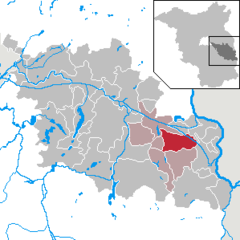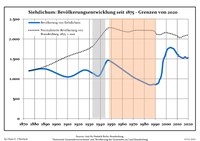Siehdichum | |
|---|---|
Location of Siehdichum within Oder-Spree district  | |
| Coordinates: 52°11′40″N 14°32′0″E / 52.19444°N 14.53333°E | |
| Country | Germany |
| State | Brandenburg |
| District | Oder-Spree |
| Municipal assoc. | Schlaubetal |
| Subdivisions | 3 districts |
| Government | |
| • Mayor (2024–29) | Robert Meus[1] |
| Area | |
| • Total | 73.00 km2 (28.19 sq mi) |
| Highest elevation | 74 m (243 ft) |
| Lowest elevation | 51 m (167 ft) |
| Population (2022-12-31)[2] | |
| • Total | 1,514 |
| • Density | 21/km2 (54/sq mi) |
| Time zone | UTC+01:00 (CET) |
| • Summer (DST) | UTC+02:00 (CEST) |
| Postal codes | 15890 |
| Dialling codes | 033653/4/6 |
| Vehicle registration | LOS |
Siehdichum is a municipality in the Oder-Spree district, in Brandenburg, Germany. The name literally means "have a look around you".
History
[edit]The municipality of Siehdichum was formed in 2003 by merging the municipalities of Pohlitz, Rießen and Schernsdorf.
From 1815 to 1947, the constituent localities of Siehdichum were part of the Prussian Province of Brandenburg.
After World War II, Pohlitz, Rießen and Schernsdorf were incorporated into the State of Brandenburg from 1947 to 1952 and the Bezirk Frankfurt of East Germany from 1952 to 1990. Since 1990, they are again part of Brandenburg, since 2003 united as the municipality of Siehdichum.
Demography
[edit]-
Development of population since 1875 within the current Boundaries (Blue Line: Population; Dotted Line: Comparison to Population development in Brandenburg state; Grey Background: Time of Nazi Germany; Red Background: Time of communist East Germany)
|
|
|
References
[edit]- ^ Landkreis Oder-Spree Wahl der Bürgermeisterin / des Bürgermeisters. Retrieved 10 July 2024.
- ^ "Bevölkerungsentwicklung und Bevölkerungsstandim Land Brandenburg Dezember 2022" (PDF). Amt für Statistik Berlin-Brandenburg (in German). June 2023.
- ^ Detailed data sources are to be found in the Wikimedia Commons.Population Projection Brandenburg at Wikimedia Commons





Well, that’s interesting to know that Psilotum nudum are known as whisk ferns. Psilotum nudum is the commoner species of the two. While the P. flaccidum is a rare species and is found in the tropical islands. Both the species are usually epiphytic in habit and grow upon tree ferns. These species may also be terrestrial and grow in humus or in the crevices of the rocks.
View the detailed Guide of Psilotum nudum: Detailed Study Of Psilotum Nudum (Whisk Fern), Classification, Anatomy, Reproduction